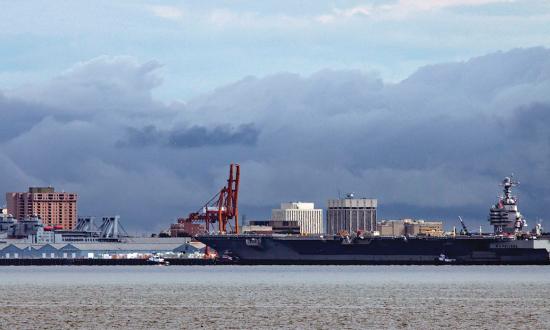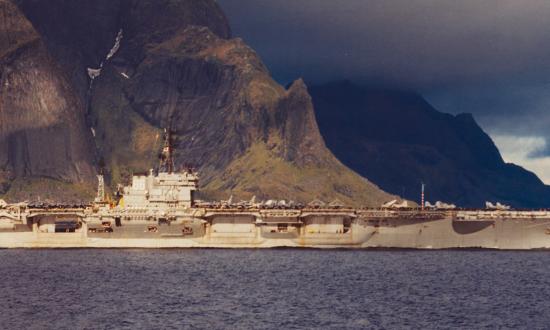The Maritime Administration (MarAd) has begun implementing a bold initiative—the National Security Multi-Mission Vessel (NSMV) construction program. It will result in a five-ship class of federal ships contracted and built according to commercial fixed-price practices. The Department of the Navy could use this novel approach to procure non-warship naval auxiliary vessels, built in U.S. shipyards, though doing so would require an attitude change and new skills for the federal workforce.
Beginning the Process: Legislation
The preamble for this approach lies in the authorizing legislation, which had its origins in the persistent efforts of the MarAd team—working in strategic cooperation with a coalition of state maritime academies—to replace the existing patchwork flotilla of aged and obsolete training ships, some of which are more than 50 years old.
Sensitive to the dire need for new training ships, Congress in 2014 appropriated $5 million to develop a design. MarAd chose to hire and work with Hebert Engineering, Inc., to develop the new design. Stakeholders—including the state maritime academies, the Coast Guard and Navy, and the Federal Emergency Management Agency, among others—held meetings to design a vessel that could serve as a state-of-the-art training ship for U.S. Merchant Marine Academy cadets and a national humanitarian-response ship deployable on contingency missions with as few as five days’ notice.
The result was a mature, custom ship design, tow-tank tested—ready to go when, in the 2017 National Defense Authorization Act, Congress provided funding for vessel construction.1 The provision was subject to the availability of appropriations “for the National Security Multi-Mission Vessel Program, including funds for the construction, planning, administration, and design of school ships,” with a certificate of documentation and coastwise endorsement.
Importantly, Congress specified that the vessel “shall be constructed using commercial design standards and commercial construction practices that are consistent with the best interests of the Federal Government.” This unique characteristic was buttressed by the additional requirement that the Maritime Administrator provide for an entity other than MarAd to contract for construction of the vessel.
Congress’s specifications are key because the touchstone of commercial ship construction is a fixed-price contract based on a mature design, in which risk is mitigated during lengthy contract negotiations between the ship owner and the shipyard. The standard commercial result is a fixed-price contract with a firm delivery date.2
In fact, a Government Accountability Office (GAO) study comparing the processes used by the Navy with those used by commercial shipbuilders is elucidating.3 The NSMV is designed to use off-the-shelf commercial technology and, of course, carries no weapon systems. Even so, during the design development period, Naval Sea Systems Command experts said using Navy shipbuilding requirements and Department of Defense contracting processes to build the same ship likely would result in an estimated final cost of $750 million to $1.2 billion per ship. Using a commercial design and contract process, the NSMV is expected to cost about $300 million per ship.
Then–Secretary of Transportation Elaine Chao considered the NSMV a critical national infrastructure investment. Backing her words with action, she allocated $300 million from the Department of Transportation’s (DoT’s) authorized funding for a commercial fixed-price contract to build the lead ship.
Following the allocation of funds, Maritime Administrator Rear Admiral Mark Buzby appointed a MarAd team led by Associate Administrator for Strategic Sealift Kevin Tokarski to select a vessel construction manager (VCM) through a best-value competitive acquisition process. U.S. companies with recent Jones Act–compliant commercial shipbuilding experience—in U.S. shipyards—responded to the request for proposals, with TOTE Services submitting the winning bid.
Finding Shipbuilding Contract Experience
As the program launched, MarAd faced various challenges. On one hand, MarAd had to follow Federal Acquisition Regulations (FAR) to negotiate and issue a contract for VCM services. On the other hand, the VCM would negotiate a commercial construction contract with a shipyard. Comparing the two contracts would be like comparing apples with oranges.
Steeped in the FAR process, the MarAd acquisition team had no recent experience with commercial shipbuilding. MarAd had not been involved in commercial shipbuilding since the 1960s, when the shipbuilding construction subsidy program was largely phased out. The last version of a standard MarAd shipbuilding contract was proposed in 1980.4 MarAd Office of Chief Counsel attorneys faced a similar dilemma: They lacked commercial shipbuilding contract experience.
The VCM had fresh shipbuilding experience and expertise and some acquisition-regulation experience, but the commercial shipyard had no FAR experience. The contrasting experiences created a challenging learning curve for MarAd. Understandably, the novel circumstances generated some tension for the three MarAd teams—acquisitions, legal, and program—required to contract for the VCM and properly supervise the many moving parts to the project. Then-Deputy Maritime Administrator Richard Balzano, whose last Navy active-duty assignment had been as an international project manager with the F-35C program, created the Executive Steering Group (ESG) to sort out conflicts, coordinate actions, and make sure decisions are taken on time. The ESG consists of the Maritime Administrator, the Deputy Maritime Administrator, and the heads of the acquisitions, legal, and program teams. The ESG enabled MarAd to speak with a coordinated voice during interactions with the VCM.
To add shipbuilding contract experience, the Office of Chief Counsel recommended retaining an outside admiralty attorney with deep experience in shipbuilding. Although acquisitions contract staff resisted a non-FAR-based process, Rear Admiral Buzby, with the support
of Secretary Chao, directed retaining an admiralty attorney with shipbuilding experience. A competitive selection process resulted in the appointment of Robert Gruendel, a seasoned admiralty shipbuilding attorney, to the MarAd team.
The result was a credit enhancement agreement that allowed for practical commercial means to protect the federal government from insolvency risks of the shipyard during the construction process. The agreement included provisions for builder’s risk insurance, partial bonds, independent monitoring of the shipyard’s cash flow and financial stability, union no-strike agreements, city forbearance commitments, and rolling Uniform Commercial Code liens on equipment and materials delivered to the shipyard during the construction process. These requirements were vital to accepting a contract from a shipyard that had an empty order book.
Animated internal discussions ensued involving MarAd’s strategic sealift program, acquisitions, and legal teams on structuring the VCM bid, especially regarding the FAR’s effect on the commercial shipbuilding contract. More than 170 FAR provisions required in a federal contract were scrutinized, and many were eliminated. Only those dictated by law for flow down were included as shipbuilding contract requirements. Another milestone in the acquisitions learning curve presented itself: A VCM independently holds the competitive bidding process to select the winning U.S. shipbuilder.
For this process, MarAd adopted a “trust but verify” posture, which had an important advantage: It insulated both DoT and MarAd from the relentless lobbying of vendors, members of Congress, and others who wanted to steer the contract to their constituents and companies. Ethical conflicts for both DoT and MarAd were relatively easy to disarm by informing the lobbyists that the decisions were not being made by MarAd, but rather by the VCM.
The VCM Takes Charge
The VCM and its competitively selected shipyard, released from political pressure, could make the myriad decisions required to keep ship cost at the lowest fixed price—consistent with both the targeted mission goals for the ship and contract requirements. This method allowed third-party flexibility and balance with respect to labor rate requirements, geographical labor differences, and Build America requirements. The last requirement is especially tricky in U.S. ship construction.
While all would prefer a ship that is 100 percent built with U.S.-produced products, the reality is that many ship components are no longer made in this country. The coastwise endorsement required in the statute required that at least 98.5 percent of the steel used in building the ship be made in the United States. For other components, the contract expressed a preference for U.S.-manufactured components when they existed, but the VCM (not MarAd) had to consider price issues in the context of overall ship cost to meet the desired $300 million price per ship. The VCM decision to use U.S.-built GE main engines was a competitive one. When foreign-built components were the only ones available, the contract required, in almost all cases, that the components be transported on U.S.-flag merchant ships.
The lesson for a federal commercial fixed-price ship contract program is that the commercial-independent VCM is a critical link in the supply chain. Government agencies are not well equipped to resist powerful lobbyists, who enlist their congressional representatives to intervene on their behalf in the contract and equipment selection process.
The MarAd contract specifies that the VCM will conduct the private shipyard competition to build the MarAd-designed ship in the United States as it would for a ship it builds for its company. A key factor was the contract requirement that the first ship be delivered in time to carry out a training cruise in May 2023. A sobering fact the competition made evident is that only about five U.S. shipyards have the capability to build the NSMV. This shipyard selection process was precarious because these shipyards are also working on lucrative Navy and Coast Guard ship construction contracts and other commercial projects, all competing for limited shipyard space with tight delivery schedules.
The VCM independently selected Philly Shipyard, informed MarAd of the decision, and engaged in lengthy contract negotiations. The fact that MarAd was kept informed, but was not at the table, is a difficult but crucial feature of a federal entity working with a VCM. If MarAd had engaged in the negotiations, the VCM would have become a MarAd agent, and the shipyard contract would have effectively been converted into a federal government contract. If that had occurred, the shipyard subcontractor would have been able to file a grievance with MarAd to dispute adverse shipyard component and equipment selection decisions.
Keeping MarAd, the VCM, and the shipyard in their separate lanes requires careful attention. A major MarAd challenge is training and instilling discipline in its staff throughout the learning curve, which involved:
• Not engaging directly in negotiation
• Not intervening and micromanaging
• Maintaining the contractual relationship with the VCM while leaving it alone to manage the contract with the shipyard
At the conclusion of the negotiations, the VCM presented the shipbuilding contract. MarAd had only two choices: either accept or reject the contract.
To keep the forward momentum, MarAd will be required to maintain the training and discipline in its workforce throughout the construction process. MarAd’s shipyard representatives monitor VCM compliance with its MarAd contract; they do not interface with the shipyard. All construction decisions are made between the VCM and the shipyard.
Discipline must be constant to resist shipyard change orders. Given the mature design, use of off-the-shelf technology, and commercial practices for fixed-price contracts, few valid grounds exist to justify a VCM- or shipyard-driven change order. It remains to be seen if this discipline can be maintained. Experience to date suggests that this is an area that requires sustained attention and scrutiny by MarAd leaders.
Time will tell if this experiment in federal shipbuilding succeeds. Indications so far are positive, with the keel-laying for NSMV 1 held on 10 December 2021 and steel cutting for NSMV 2 on 3 March 2021. As this progress continues, MarAd will receive, for a total fixed price of about $1.5 billion, five state-of-the-art training and humanitarian-assistance ships delivered on schedule, and this model for federal ship procurement will be proven.
Based on the MarAd experience, Navy shipbuilding leaders should not think the new process is easy to implement. Success requires a concerted effort to change processes, train acquisition managers, and upgrade federal government skills by adding commercial skills to learn a new way to build naval auxiliaries. Complacency must give way to innovation.
Navy shipbuilding is known for cost overruns and delivery delays. For warships with evolving technologies, weapon systems, and a multitude of changing missions, commercial shipbuilding practices have limited application. But for underway replenishment tankers, hospital ships, cable layers, logistic supply ships, naval auxiliaries, and many autonomous vessel applications, the NSMV fixed-price model using commercial U.S. shipyards offers a fresh approach to increase Navy hulls at sea in a rapid and cost-effective way.
1. U.S. Congress, National Defense Authorization Act, 114th Congress, Sec. 3505, “National Security Multi-Mission Vessel.”
2. Simon Curtis, The Law of Shipbuilding Contracts, 4th ed (Oxfordshire, UK: Routledge, 2012), 7–13.
3. Government Accountability Office, High Levels of Knowledge at Key Points Differentiate Commercial Shipbuilding from Navy Shipbuilding (Washington, DC: Government Accountability Office, May 2009).
4. “MarAd Contracts Shipbuilding Contract of the Maritime Subsidy Board of the United States Department of Commerce Maritime Administration (MarAd),” Appendix 3, in Shipbuilding Contracts, 2nd ed. (London: Lloyds of London Press Ltd, 1992).








